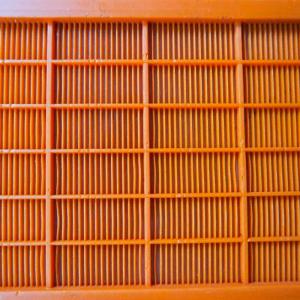

Add to Cart
Wet and Dry Screens Polyurethane Fine Screen Mesh For Screening Machines
Description For Wet and Dry Screens Polyurethane Fine Screen Mesh For Screening Machines:
Wet and Dry Screens Polyurethane Fine Screen Mesh For Screening Machines is made of polyurethane sheet with high quality screen surface. Wet and Dry Screens Polyurethane Fine Screen Mesh For Screening Machines is abrasion resistance and much longer service life than the woven vibrating screen mesh. Moreover, the property of anti-blinding makes it feasible to screen materials which is considered difficult or impossible to screen previously. Wet and Dry Screens Polyurethane Fine Screen Mesh For Screening Machines has an extremely fine openings which is as fine as 0.045mm, which is suitable for a wide variety of wet and dry applications.
Datasheet For Wet and Dry Screens Polyurethane Fine Screen Mesh For Screening Machines:
| Item | Wet and Dry Screens Polyurethane Fine Screen Mesh For Screening Machines |
| Material | Polyurethane |
| Aperture Ratio | 35% ~43% |
| Size | 1040*700mm, others can be designed |
| Color | Red, orange or others |
| Usage | Screening |
| Warranty | 6-12 Months |
| Application | Mining Separatotion |
Advantages For Wet and Dry Screens Polyurethane Fine Screen Mesh For Screening Machines:
Wet and Dry Screens Polyurethane Fine Screen Mesh For Screening
Machines with low noise and low maintenance, is the replacement
products of perforated vibrating screen mesh. Additional, the Wet
and Dry Screens Polyurethane Fine Screen Mesh For Screening
Machines has higher wear resistance and acid and alkali resistance
than the woven vibrating screen mesh.
There are hooks on the both side of Wet and Dry Screens
Polyurethane Fine Screen Mesh For Screening Machines, which make it
easy to install the screen mesh onto vibrating screens. Wet and Dry
Screens Polyurethane Fine Screen Mesh For Screening Machines offer
an extended wear life, given their flexible nature and polyurethane
coating. Customers have reported between four and 10 times the life
expectancy, dependent on product, regional conditions and finished
product size. Not only does this extend the initial screen cost
over a longer period, it also offers a substantial increase in
production time available. Reducing the requirement to stop
multiple times a year for change-overs has provided customers with
increased capacity equating to $10,000 to $20,000 of increased
finished product. This is without accounting for the labour and
machine hire savings.
